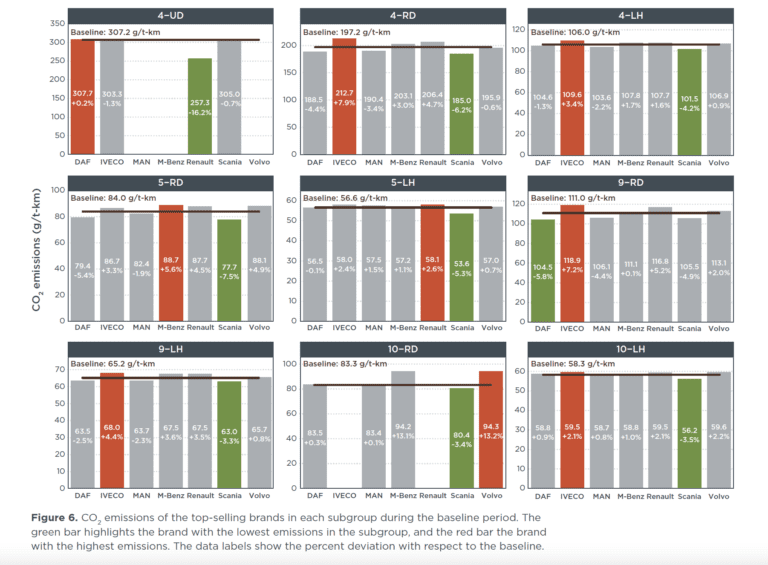The recently published EU Heavy Vehicle Certifications are a valuable source of information for assessing baseline values for CO2 standards, tracking the progress truck manufacturers are making towards reduction targets, and understanding the different technology paths manufacturers have chosen to achieve their goals. Decarbonizing their fleets. This paper analyzes key data to understand how the industry is currently performing compared to the targets set by the European Commission. The analysis aims to inform discussions about the review of the standards that will take place in 2022.
The study found that while fuel consumption values across different subgroups of trucks ranged between 24 l/100km and 33 l/100km, specific CO2 emissions showed greater variation. Urban delivery trucks with a 4×2 axle configuration (4-UD) emit an average of 307 g CO2/tkm, five times more than long-haul (5-LH) tractor trailers with emissions of 57 g CO2 carbon/t km. In addition, for most vehicle subgroups, the baseline data show a large spread around the mean. For long-haul (5-LH) tractor trailers, there was a 63% difference between the best and worst performing vehicles. This indicates that even today, there is great technological potential that is not being exploited by truck manufacturers and buyers.
During the first reporting period, a total of 47 zero-emission trucks were registered by the best-selling brands in the regulated groups. There were no low-emission trucks – defined as having less than half the baseline CO2 emissions for the subgroup in question – registered. The low market penetration of zero-emission trucks has had virtually no impact on manufacturers’ average fleet emissions.
The data also showed that differences in CO2 emissions between manufacturers could be explained by different rates of technology adoption. DAF and MAN trucks have the most efficient engines, with an average engine efficiency of 42.6% compared to WHTC, while the highest-performance models have an average efficiency compared to WHTC of around 44%. Natural gas engines, favored by IVECO, have much lower thermal efficiency than diesel. The best performing model, the IVECO engine, achieved just 38.1% efficiency compared to the WHTC. At the vehicle level, this lower engine efficiency largely offsets the potential gains from the lower carbon content of natural gas. Aerodynamics were the main driver of Scania’s good CO2 performance, recording the lowest average air intake values of 4.63 m² for long-haul (5-LH) tractor trailers – around 20% lower than other manufacturers’ average. Scania underperformed its reference emissions by 4.7%, resulting in an early credit backlog that can be estimated at around €328 million when using the 2025 non-compliance penalty of €4,250 per gram of CO2 per tonne.
Attachments
EU-HDV-CO2-standards-baseline-data-supplement-sept21.pdf





